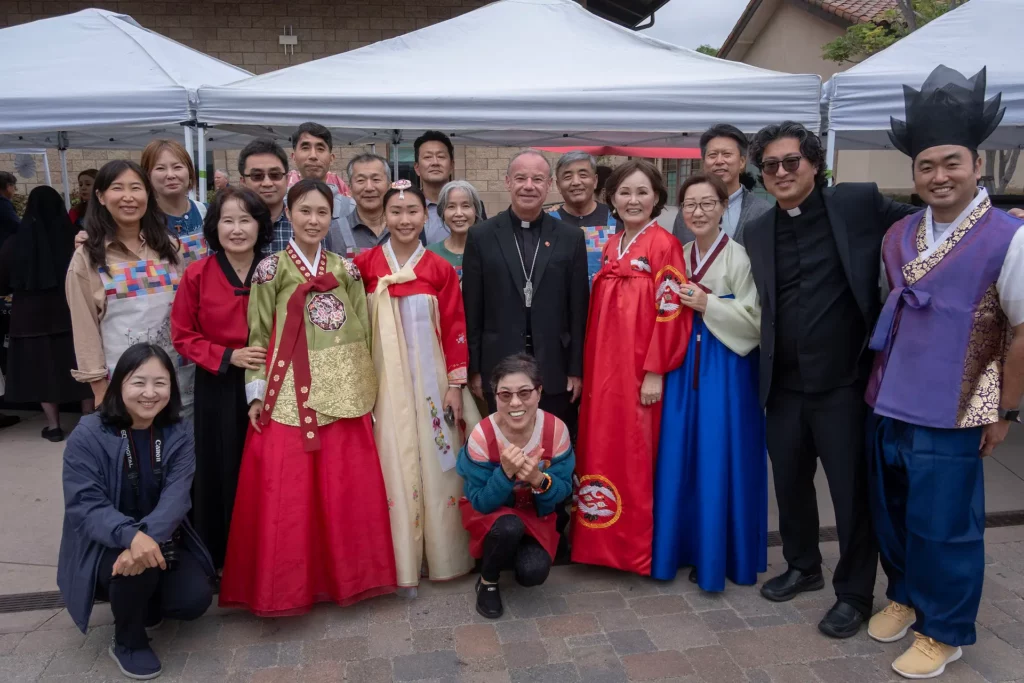Our diocese embraces cultural diversity as a strength of our Church while promoting unity among all Catholics.

“In the Diocese of San Diego, we must strive to build love and unity in the midst of our diversity. Pope Francis explains that, ‘Unity does not imply uniformity; it does not necessarily mean doing everything together or thinking in the same way. Unity in diversity is actually the opposite: it involves the joyful recognition and acceptance of the various gifts which the Holy Spirit gives to each one and the placing of these gifts at the service of all members of the Church.”
– Auxiliary Bishop Ramón Bejarano
Explore the vibrant tapestry of our diocesan community





The statue depicts the Blessed Mother carrying young Jesus, who is holding St. Peter’s Basilica, a symbol of our earthly Church. As the annual Pentecost celebration gathers all of us as brothers and sisters, One in Christ (Unum in Christi), her mantle embraces the diverse cultures of our local diocese, and several saints that accompany us on our spiritual journey.
Under the Blessed Mother’s mantle at the front are children representing the cultural families, as designated by the U.S. Conference of Catholic Bishops: Asian-Pacific Islander, Euro American, African American, Hispanic and Native American.
Immerse yourself in a visual journey that captures the colors, traditions, and shared moments of faith within our diocese. From cultural events to community gatherings, witness the richness that defines our collective spirit.








Please reach out to our office staff, which is ready to assist you.
Director for Priestly Vocations, Explorer Days
vocations, priest-vocation
Assistant to the Vicar
Executive Assistant
Please reach out to our office staff, which is ready to assist you.
Vicar for Office for Ethnic and Intercultural Communities
Assistant to the Vicar
Follow the news about our Catholic community,
in English and Spanish.
Bishop Pulido’s coat of arms is divided into four quarters with wavy horizontal lines from top to bottom. The blue and white lines represent the Blessed Virgin Mary. They also suggest water, which alludes to Jesus washing the feet of His disciples and to the waters of baptism. The red and gold lines represent the Holy Spirit and fire. The colors also can be seen as referring to the Blood that (along with water) poured from Jesus’ side at His crucifixion, as well as to the bread (gold) and wine (red) transformed into the Eucharist. At the center is a roundel featuring a symbolic representation of the “mandatum” (washing of the feet), which he believes exemplifies service to all humanity. The roundel’s outer edge is a line composed of small humps; it is borrowed from the coat of arms of the Diocese of Yakima, where Bishop Pulido served as a priest before being named a bishop.
Bishop Pham’s coat of arms depicts a red boat on a blue ocean, which is crisscrossed by diagonal lines suggesting a fisherman’s net. This symbolizes his ministry as a “fisher of men,” as well as how his own father had been a fisherman. The boat is also a symbol of the Church, which is often referred to as the “barque of Peter.” At the center of the sail is a red beehive (a symbol of the bishop’s baptismal patron saint, St. John Chrysostom, who was known as a “honey-tongued” preacher). The beehive is surrounded by two green palm branches (an ancient symbol of martyrdom; the bishop’s ancestors were among Vietnam’s first martyrs). The eight red tongues of fire around the boat are a symbol of the Holy Spirit and a representation of the diversity of ethnic and cultural communities. The red of the boat, the beehive and the tongues of fire allude to the blood of the martyrs.
The coat of arms combines symbols that reflect Bishop Bejarano’s spiritual life and priestly ministry. The main part of the shield shows four wavy vertical lines on a gold background. These represent flowing waters. This alludes to his chosen motto and also symbolizes the graces that come from the Divine life to quench our thirst for God. The upper third of the shield is red because it is borrowed from the coat of arms of the Order of Mercy, of which the Bishop’s patron saint, Raymond Nonnatus, was a member. The central symbol resembles a monstrance because St. Raymond is often depicted holding one. The Eucharist is Bishop Bejarano’s inspiration for his vocation. It was through the Eucharist that he received his call to the priesthood at age seven and which keeps his faith and his ministry going. It represents the call to offer oneself as a living sacrifice. The monstrance is flanked on either side by an image of the Sacred Heart, alluding to the mercy of God and echoing the idea of a sacrificial offering of oneself united to the sacrifice of Christ, and of a rose for Our Lady. It is an allusion to Our Lady of Guadalupe, patroness of the Americas, and highlights the bishop’s Hispanic heritage.